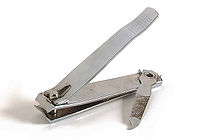
Compound lever
Encyclopedia

Lever
In physics, a lever is a rigid object that is used with an appropriate fulcrum or pivot point to either multiply the mechanical force that can be applied to another object or resistance force , or multiply the distance and speed at which the opposite end of the rigid object travels.This leverage...
is a simple machine
Simple machine
A simple machine is a mechanical device that changes the direction or magnitude of a force.In general, they can be defined as the simplest mechanisms that use mechanical advantage to multiply force. A simple machine uses a single applied force to do work against a single load force...
operating on the premise that the resistance from one lever in a system of levers will act as power for the next, and thus the applied force will be amplified from one lever to the next (as long as the mechanical advantage for each lever is greater than one). Almost all scale
Weighing scale
A weighing scale is a measuring instrument for determining the weight or mass of an object. A spring scale measures weight by the distance a spring deflects under its load...
s use some sort of compound lever to work. Other examples include nail clippers and piano
Piano
The piano is a musical instrument played by means of a keyboard. It is one of the most popular instruments in the world. Widely used in classical and jazz music for solo performances, ensemble use, chamber music and accompaniment, the piano is also very popular as an aid to composing and rehearsal...
keys.
Mechanical advantage
A leverLever
In physics, a lever is a rigid object that is used with an appropriate fulcrum or pivot point to either multiply the mechanical force that can be applied to another object or resistance force , or multiply the distance and speed at which the opposite end of the rigid object travels.This leverage...
arm uses the fulcrum to lift the load using and intensifying an applied force
Force
In physics, a force is any influence that causes an object to undergo a change in speed, a change in direction, or a change in shape. In other words, a force is that which can cause an object with mass to change its velocity , i.e., to accelerate, or which can cause a flexible object to deform...
. In practice, conditions may prevent the use of a single lever to accomplish the desired result, e.g., a restricted space, the inconvenient location of the point of delivery of the resultant force, or the prohibitive length of the lever arm needed. In these conditions, combinations of simple levers, called compound levers, are used. Compound levers can be constructed from first, second and/or third-order levers. In all types of compound lever, the rule is that force multiplied by the force arm equals the weight multiplied by the weight arm. The output from one lever becomes the input for the next lever in the system, and so the advantage is magnified.
The figure on the left illustrates a compound lever formed from two first-class levers, along with a short derivation of how to compute the mechanical advantage. With the dimensions shown, the mechanical advantage, W/F can be calculated as(9x10)/(3x4)= 7.5 This means that an applied force of 1 pound (or 1 kg) could lift a weight of 7.5 lb (or 7.5 kg).
Alternately, if the position of the fulcrum on lever AA' were moved so that A1=4 units and A2=9 units, then the mechanical advantage W/F is calculated as (4x9)/(9x4) = 1 This means that an applied force will lift an equivalent weight and there is no mechanical advantage. This is not usually the goal of a compound lever system, though in rare situations the geometry may suit a specific purpose.
Examples

Handloading
Handloading or reloading is the process of loading firearm cartridges or shotgun shells by assembling the individual components , rather than purchasing completely assembled, factory-loaded cartridges...
bullets, minting coins and medals, and in hole punching. Compound balances are used to weigh heavy items. These all use multiple levers to magnify force to accomplish a specific purpose. The train brake translates the force of pushing back the stick to the levers and they rub against the wheels, using friction to slow and eventually stop the train. These are everyday applications of this mechanism.

History
The earliest remaining writings regarding levers date from the 3rd century BC and were provided by ArchimedesArchimedes
Archimedes of Syracuse was a Greek mathematician, physicist, engineer, inventor, and astronomer. Although few details of his life are known, he is regarded as one of the leading scientists in classical antiquity. Among his advances in physics are the foundations of hydrostatics, statics and an...
. "Give me a place to stand, and I shall move the earth with a lever" is a remark attributed to Archimedes, who formally stated the correct mathematical principle of levers (quoted by Pappus of Alexandria).
The idea of the compound lever is attributed to the Birmingham
Birmingham
Birmingham is a city and metropolitan borough in the West Midlands of England. It is the most populous British city outside the capital London, with a population of 1,036,900 , and lies at the heart of the West Midlands conurbation, the second most populous urban area in the United Kingdom with a...
inventor John Wyatt
John Wyatt (inventor)
John Wyatt , an English inventor, was born near Lichfield and was related to Sarah Ford, Doctor Johnson's mother. A carpenter by trade he began work in Birmingham on the development of a spinning machine...
in 1743, when he designed a weighing machine
Weighing scale
A weighing scale is a measuring instrument for determining the weight or mass of an object. A spring scale measures weight by the distance a spring deflects under its load...
that used four compound levers to transfer a load from a weighing platform to a central lever from which the weight could be measured.

